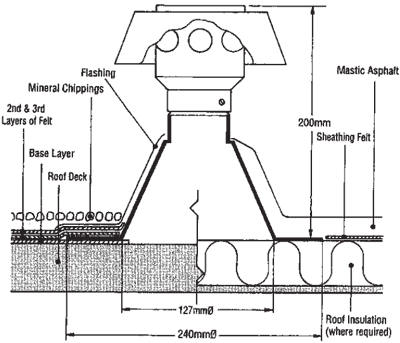
Optimizing Comfort and Efficiency: Flat Roof Ventilation Explained
Understanding the Importance of Ventilation
Flat roofs offer a sleek and modern aesthetic to buildings, but without proper ventilation, they can become hot and stuffy spaces. Ventilation is essential for regulating temperature, reducing moisture buildup, and improving indoor air quality in flat roof structures. By implementing effective ventilation systems, homeowners can create more comfortable and energy-efficient living spaces.
Exploring Different Ventilation Methods
There are several methods for ventilating flat roofs, each with its own benefits and considerations. Passive ventilation systems, such as vents and louvers, rely on natural airflow to remove hot air and moisture from the roof cavity. Active ventilation systems, such as fans and turbines, use mechanical components to enhance airflow and expel stale air more effectively. Understanding the options available can help homeowners choose the best ventilation solution for their needs.
Addressing Common Ventilation Challenges
Flat roof ventilation can present unique challenges, particularly in buildings with limited space or complex architectural designs. Ensuring adequate airflow across the entire roof surface can be challenging, especially in areas with low or no pitch. Additionally, factors such as insulation, roofing materials, and building codes must be taken into account when designing a ventilation system. By working with experienced professionals, homeowners can overcome these challenges and achieve optimal ventilation in their flat roofs.
The Benefits of Proper Ventilation
Proper ventilation offers numerous benefits for flat roof structures and the occupants within them. By reducing heat buildup, ventilation can help lower cooling costs and extend the lifespan of roofing materials. Improved airflow also helps prevent moisture-related issues such as mold, mildew, and rot, which can compromise the structural integrity of the roof and pose health risks to residents. Additionally, adequate ventilation promotes better indoor air quality, creating a more comfortable and healthy living environment.
Factors to Consider in Ventilation Design
When designing a ventilation system for a flat roof, several factors must be considered to ensure its effectiveness. These include the size and layout of the roof, the climate and weather conditions in the area, and the intended use of the building. Additionally, factors such as insulation levels, building orientation, and local building codes may influence ventilation design decisions. By carefully considering these factors, homeowners can create a ventilation system that meets their specific needs and maximizes the benefits of proper airflow.
Choosing the Right Ventilation Products
Selecting the right ventilation products is crucial for achieving optimal airflow and performance in flat roof structures. Vents, louvers, fans, and other ventilation components should be chosen based on factors such as size, capacity, and compatibility with existing roofing materials. It’s essential to select high-quality products from reputable manufacturers to ensure durability and reliability over time. Working with knowledgeable contractors or ventilation specialists can help homeowners select the best products for their ventilation needs.
Ensuring Proper Installation and Maintenance
Proper installation and maintenance are key to the long-term effectiveness of a flat roof ventilation system. Vents, fans, and other components must be installed correctly to ensure optimal airflow and performance. Regular inspections and maintenance are also essential to identify any issues early and prevent potential problems from occurring. By staying proactive with maintenance and addressing any issues promptly, homeowners can ensure that their flat roof ventilation system continues to operate efficiently for years to come.
Conclusion
Flat roof ventilation is essential for maintaining comfort, efficiency, and structural integrity in buildings with flat roofs. By understanding the importance of ventilation, exploring different ventilation methods, addressing common challenges, and choosing the right products and installation methods, homeowners can create a healthy and comfortable living environment in their flat roof structures. With proper ventilation in place, residents can enjoy improved indoor air quality, reduced energy costs, and greater peace of mind knowing their roof is well-protected. Read more about flat roof ventilation
